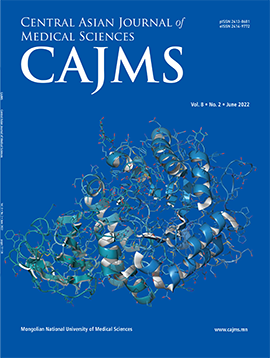Mid-Term Results of High Tibial Osteotomy Regarding From Grades of Knee Osteoarthritis
DOI:
https://doi.org/10.24079/cajms.2022.06.003Keywords:
Knee Joint, Osteoarthritis, Arthritis, Joint Diseases, Orthopedics, Musculoskeletal DiseasesAbstract
Objectives: The number of high tibial osteotomy (HTO) has significantly increased in Mongolia, however, researchers are still debating about the impact of severity of knee osteoarthritis on the outcome of high tibial osteotomy. The purpose of our study is to report the mid-term results of HTO for knee osteoarthritis according to the Kellgren Lawrence classification. Methods: A total of 100 patients who underwent high tibial osteotomy for knee osteoarthritis from October 2019 to June 2020 at the Joint Center of the First Central Hospital of Mongolia participated in this study. Outcome evaluation of the participants was accomplished at baseline, at 2 months, 6 months, 8 months and 18 months post-operatively. Results: Lateral closing wedge HTO was performed in 54.2 % of patients who had 1st grade deformity and 55.9 % of patients who had 2nd grade deformity. On the other hand, medial opening wedge HTO was performed in 3rd grade patients compared to other grades. WBL was 11.43 ± 8.22 at preoperative, and increased to 56.31 ± 4.52 after 12 months of the surgery in 3rd grade. The total WBL was improved from 20.54 ± 12.57 to 57.24 ± 3.69 after two months of surgery and 57.89 ± 4.17 after 12 months. Conclusion: Our study showed that the severity of knee osteoarthritis had impact on outcome of high tibial osteotomy.
Downloads
250
Downloads
Published
How to Cite
Issue
Section
License
Copyright (c) 2022 Mongolian National University of Medical Sciences

This work is licensed under a Creative Commons Attribution-NonCommercial 4.0 International License.




